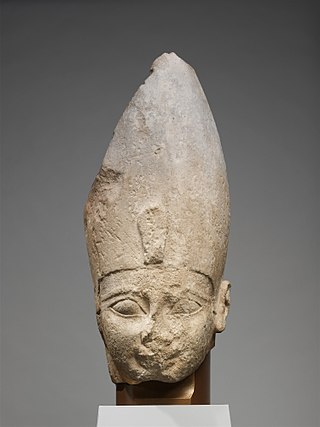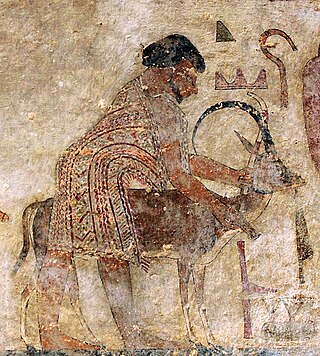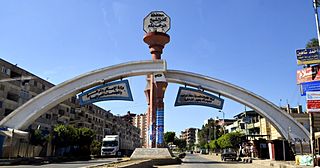Hieroglyphic Descriptor
|
|
|
|
Nefrusy was an ancient Egyptian city which location is north of modern day cities of El Ashmunein and El Quseyya. It is known for being the site of Battle of Nefrusy between the forces of Kamose and Hyksos forces, which saw the first attested use of chariots in the history of Military of ancient Egypt. [1]
In the Old Kingdom, Nefrusy is first attested in a tomb at Hebenu where Hathor, mistress of Nefrusy is mentioned.
In the Middle Kingdom, the place is mentioned several times in the tombs of Beni Hasan where Hathor, lady of Nefrusy is also mentioned. Hetepet, consort of the nomarch Amenemhet was a priestess of Hathor of Nefrusy. [2] Under Teti son of Pepi, Nefrusy is described in the victory stela of Kamose as a 'nest of Asiatics'. [3] Kamose destroyed Nefrusy on his campaign against the Hyksos. [4]
In the New Kingdom, other mayors residing there were Iuno, Mahu, Iamunefer, Pahahauti are known by name. [5]
|
|
|
|
Its location has been suggested by Gaston Maspero to be at modern village of Etlidem 27 km (17 mi) south of Minya, and by Georges Daressy to be at modern village of Balansourah on the canal of Bahr Yussef 12 km (7.5 mi) west of Abu Qirqas. [6]

Ahmose I was a pharaoh and founder of the Eighteenth Dynasty of Egypt, classified as the first dynasty of the New Kingdom of Egypt, the era in which ancient Egypt achieved the peak of its power. He was a member of the Theban royal house, the son of pharaoh Seqenenre Tao and nephew of the last pharaoh of the Seventeenth dynasty, Kamose. During the reign of his father or grandfather, Thebes rebelled against the Hyksos, the rulers of Lower Egypt. When he was seven years old, his father was killed, and he was about ten when his brother died of unknown causes after reigning only three years. Ahmose I assumed the throne after the death of his brother, and upon coronation became known as Nebpehtyre, nb-pḥtj-rꜥ "The Lord of Strength is Ra".

Hyksos is a term which, in modern Egyptology, designates the kings of the Fifteenth Dynasty of Egypt. The seat of power of these kings was the city of Avaris in the Nile delta, from where they ruled over Lower and Middle Egypt up to Cusae. In the Aegyptiaca, a history of Egypt written by the Greco-Egyptian priest and historian Manetho in the 3rd century BC, the term Hyksos is used ethnically to designate people of probable West Semitic, Levantine origin. While Manetho portrayed the Hyksos as invaders and oppressors, this interpretation is questioned in modern Egyptology. Instead, Hyksos rule might have been preceded by groups of Canaanite peoples who gradually settled in the Nile delta from the end of the Twelfth Dynasty onwards and who may have seceded from the crumbling and unstable Egyptian control at some point during the Thirteenth Dynasty.

Tanis or San al-Hagar is the Greek name for ancient Egyptian ḏꜥn.t, an important archaeological site in the north-eastern Nile Delta of Egypt, and the location of a city of the same name. It is located on the Tanitic branch of the Nile, which has long since silted up. The first study of Tanis dates to 1798 during Napoléon Bonaparte's expedition to Egypt. Engineer Pierre Jacotin drew up a map of the site in the Description de l'Égypte. It was first excavated in 1825 by Jean-Jacques Rifaud, who discovered the two pink granite sphinxes now in the Musée du Louvre, and then by François Auguste Ferdinand Mariette between 1860 and 1864, and subsequently by William Matthew Flinders Petrie from 1883 to 1886. The work was taken over by Pierre Montet from 1929 to 1956, who discovered the royal necropolis dating to the Third Intermediate Period in 1939. The Mission française des fouilles de Tanis (MFFT) has been studying the site since 1965 under the direction of Jean Yoyotte and Philippe Brissaud, and François Leclère since 2013.

Kamose was the last Pharaoh of the Theban Seventeenth Dynasty. He was possibly the son of Seqenenre Tao and Ahhotep I and the brother of Ahmose I, founder of the Eighteenth Dynasty. His reign fell at the very end of the Second Intermediate Period. Kamose is usually ascribed a reign of three years, although some scholars now favor giving him a longer reign of approximately five years.

Avaris was the Hyksos capital of Egypt located at the modern site of Tell el-Dab'a in the northeastern region of the Nile Delta. As the main course of the Nile migrated eastward, its position at the hub of Egypt's delta emporia made it a major capital suitable for trade. It was occupied from about the 18th century BC until its capture by Ahmose I.

Heracleopolis Magna and Heracleopolis and Herakleoupolis (Ἡρακλεούπολις), is the Roman name of the capital of the 20th nome of ancient Upper Egypt, known in Ancient Egyptian as nn nswt. The site is located approximately 15 km (9.3 mi) west of the modern city of Beni Suef, in the Beni Suef Governorate of Egypt.

Cusae was a city in Upper Egypt. Its Ancient Egyptian name was qjs, conventionally rendered Qis or Kis. Today, the town is known as El Quseyya, and is located on the west bank of the Nile in the Asyut Governorate.

Khakheperre Senusret II was the fourth pharaoh of the Twelfth Dynasty of Egypt. He ruled from 1897 BC to 1878 BC. His pyramid was constructed at El-Lahun. Senusret II took a great deal of interest in the Faiyum oasis region and began work on an extensive irrigation system from Bahr Yussef through to Lake Moeris through the construction of a dike at El-Lahun and the addition of a network of drainage canals. The purpose of his project was to increase the amount of cultivable land in that area. The importance of this project is emphasized by Senusret II's decision to move the royal necropolis from Dahshur to El-Lahun where he built his pyramid. This location would remain the political capital for the 12th and 13th Dynasties of Egypt. The king also established the first known workers' quarter in the nearby town of Senusrethotep (Kahun).

Sharuhen was an ancient town in the Negev Desert or perhaps in Gaza. Following the expulsion of the Hyksos from Egypt in the second half of the 16th century BCE, they fled to Sharuhen and fortified it. The armies of Pharaoh Ahmose I seized and razed the town after a three-year siege.

Senakhtenre Ahmose, was a king of the Seventeenth Dynasty of Egypt during the Second Intermediate Period. Senakhtenre reigned for a short period over the Theban region in Upper Egypt at a time where the Hyksos 15th Dynasty ruled Lower Egypt. Senakhtenre died c.1560 or 1558 BC at the latest.

Apepi, Apophis ; regnal names Neb-khepesh-Re, A-qenen-Re and A-user-Re) was a Hyksos ruler of Lower Egypt during the Fifteenth Dynasty and the end of the Second Intermediate Period. According to the Turin Canon of Kings, he reigned over the northern portion of Egypt for forty years during the early half of the 16th century BCE. Although officially only in control of the Lower Kingdom, Apepi in practice dominated the majority of Egypt during the early portion of his reign. He outlived his southern rival, Kamose, but not Ahmose I.

Nubkheperre Intef was an Egyptian king of the Seventeenth Dynasty of Egypt at Thebes during the Second Intermediate Period, when Egypt was divided by rival dynasties including the Hyksos in Lower Egypt.

Sakha, also known by the ancient name of Xois is a town in Kafr El Sheikh Governorate of Egypt. Located near the center of the Nile Delta, it is a city of great antiquity, identified with the ancient Egyptian city of Ḫꜣsww(t).

Minya is the capital of the Minya Governorate in Upper Egypt. It is located approximately 245 km (152 mi) south of Cairo on the western bank of the Nile River, which flows north through the city.

Elkab, also spelled El-Kab or El Kab, is an Upper Egyptian site on the east bank of the Nile at the mouth of the Wadi Hillal about 80 kilometres (50 mi) south of Luxor. Elkab was called Nekheb in the Egyptian language, a name that refers to Nekhbet, the goddess depicted as a white vulture. In Greek it was called Eileithyias polis, "city of the goddess Eileithyia".

In ancient Egyptian society chariotry stood as an independent unit in the King’s military force. Chariots are thought to have been first used as a weapon in Egypt by the Hyksos in the 16th century BC. The Egyptians then developed their own chariot design.

Gebelein was a town in Egypt. It is located on the Nile, about 40 km south of Thebes, in the New Valley Governorate.

The following outline is provided as an overview of a topical guide to ancient Egypt:
Herwer was an ancient Egyptian town in the 16th nome in Upper Egypt. It is mentioned in several ancient inscriptions dating from the Old, Middle and New Kingdom. The main deities of the place were Khnum and Heqet, both several times called lord or lady of Herwer. Perhaps in the Middle Kingdom, the place became capital of the 16th Upper Egyptian nome. The local governor Amenemhat of that nome was indeed overseer of the priests of Khnum of Herwer. The place is often mentioned in the tombs of Beni Hasan.

The Oryx nome was one of the 42 nomoi in ancient Egypt. The Oryx nome was the 16th nome of Upper Egypt, and was named after the scimitar oryx. It was located, approximately, in the territories surrounding the modern city of Minya in Middle Egypt.